What makes a Filipino dish truly special? Can a single dish be both sweet and savory? Ginataan, a beloved food in the Philippines, is a perfect example. It’s a versatile dish that can be enjoyed in many ways.
This popular comfort food is often served at special occasions. It’s made with coconut milk, which gives it a rich and creamy texture. To learn more about the cultural significance of Filipino dishes like Ginataan, you can visit Filipino food culture resources.
Key Takeaways
- Ginataan is a versatile Filipino dish that can be both sweet and savory.
- It is a popular comfort food in the Philippines, often served at special occasions.
- The dish is made with coconut milk, which gives it a rich and creamy texture.
- Ginataan can be made with a variety of ingredients, including fruits, vegetables, and proteins.
- It is a significant part of Filipino cuisine, with various regional variations and cultural significance.
- Ginataan is a food that can be enjoyed in different ways, from sweet desserts to savory meals.
- Coconut milk is a primary ingredient in Ginataan, providing a rich source of calories and saturated fat.
What is Ginataan?
Ginataan refers to dishes cooked with coconut milk, a staple in Filipino cuisine. The term “ginataan” means “done with coconut milk.” This shows coconut milk’s key role in these dishes.
In Filipino cooking, ginataan includes many dishes. There are savory meals like ginataang hipon (shrimp in coconut milk) and ginataang gulay (vegetables in coconut milk). There are also sweet desserts like binignit, made with coconut milk, glutinous rice, tubers, tapioca pearls, and sago.
Historical Background of Ginataan
The use of coconut milk in Filipino cuisine dates back a long time. Ginataan dishes have evolved, influenced by various regional and cultural traditions. The Philippines, a major coconut producer, has coconut milk as a historical staple in its cuisine.
Regional Variations of Ginataan
There are different names and ingredients for ginataan across the Philippines. In Bikolano, it’s called “giná-tan,” and in Ilokano, it’s “ginettaán.” These variations highlight the diversity and richness of Filipino cuisine, with coconut milk being a common ingredient.
https://www.youtube.com/watch?v=UCPxdfnOnG8
- Ginataang hipon (shrimp in coconut milk)
- Ginataang gulay (vegetables in coconut milk)
- Ginataang alimango (mud crabs in coconut milk)
- Ginataang manok (chicken in coconut milk)
These dishes show ginataan’s versatility in Filipino cuisine. They range from main courses to desserts, all united by coconut milk.
Key Ingredients in Ginataan
Ginataan is a traditional Filipino dish that heavily relies on coconut milk. This ingredient makes Ginataan rich and creamy. Coconut milk is a key part of Filipino cooking, and Ginataan is no different.
Other ingredients in Ginataan include vegetables and fruits like jackfruit, calabasa, and green beans. These add sweetness and texture. For protein, pork belly and shrimp are used, making the dish flavorful and aromatic.
Some key ingredients used in Ginataan include:
- Coconut milk
- Vegetables like jackfruit and calabasa
- Fruits like green beans
- Protein sources like pork belly and shrimp
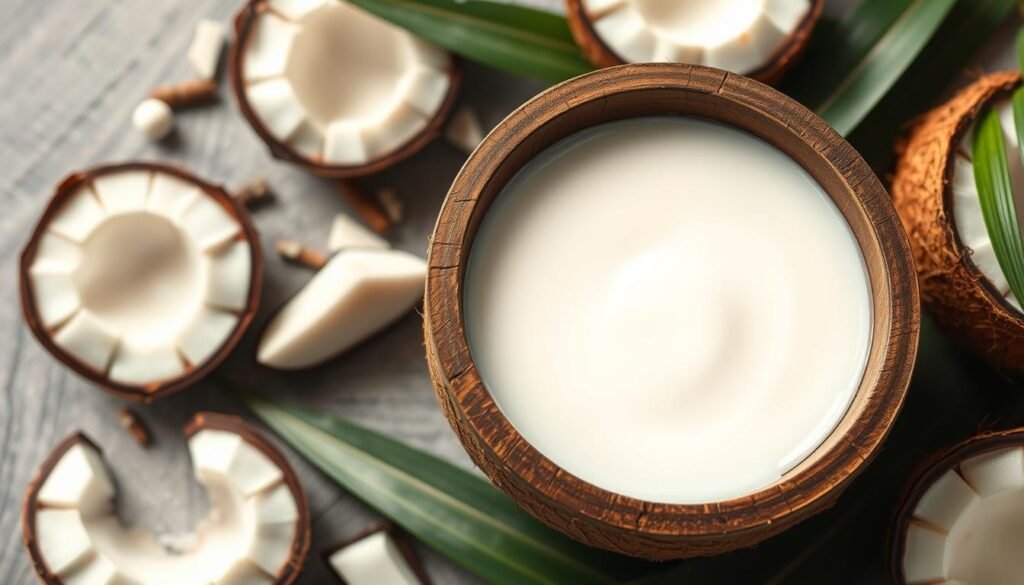
In Filipino cooking, these ingredients mix to create a unique flavor. Understanding Ginataan’s ingredients helps us see the richness and diversity of Filipino cuisine.
| Ingredient | Quantity |
|---|---|
| Coconut milk | 2 cups |
| Pork belly | ½ pound |
| Shrimp | ½ pound |
| Jackfruit | 20 ounces |
How to Prepare Basic Ginataan
Ginataan is a beloved Filipino food with many variations. To make a basic Ginataan, you need glutinous rice flour, coconut milk, and fruits or vegetables. It cooks quickly, making it a tasty and fast meal.
Here’s how to make basic Ginataan:
- Combine glutinous rice flour and water to form a dough.
- Boil the dough in coconut milk until it is cooked through.
- Add your choice of fruits and vegetables, such as sweet potatoes and plantain bananas.
- Simmer the mixture until the flavors are well combined.
This basic recipe makes a creamy, delicious Filipino food perfect for any time. You can try different ingredients and cooking methods to make your own Ginataan.
| Ingredient | Quantity |
|---|---|
| Glutinous rice flour | 2 cups |
| Coconut milk | 2 cans |
| Sweet potatoes | 2 big |
| Plantain bananas | 4 |
By following these steps and using the right ingredients, you can make a tasty Ginataan dish. It’s perfect for those who love Filipino food or want to try something new. Ginataan is easy to make and fun to eat.
Sweet Variations of Ginataan
Ginataan is a traditional Filipino dessert with many sweet treats. Ginataang Bilo-Bilo is a favorite, made with coconut milk, sugar, and tapioca pearls. It’s warm and loved on rainy days.
Ginataang Sago and Langka is another hit. It mixes coconut milk with langka (jackfruit) and sago (tapioca pearls). These desserts show how versatile coconut milk is in Filipino cooking.

- Coconut milk, which is the base of most Ginataan desserts
- Sugar, which adds sweetness to balance the flavor
- Tapioca pearls or sago, which provide a fun texture
- Langka or jackfruit, which adds natural sweetness and flavor
These treats are great for those wanting to try a unique Filipino dessert. They’re sweet, creamy, and rich. They’re a must-try for exploring Filipino cuisine.
| Dessert | Ingredients | Description |
|---|---|---|
| Ginataang Bilo-Bilo | Coconut milk, sugar, tapioca pearls | A classic Filipino dessert made with coconut milk and tapioca pearls |
| Ginataang Sago and Langka | Coconut milk, sugar, sago, langka | A sweet and creamy dessert made with coconut milk, sago, and langka |
Savory Variations of Ginataan
Ginataan is a key part of Filipino food, and it’s not just sweet. It can also be savory, showing how versatile coconut milk is. Ginataang Sitaw and Malunggay is a favorite, mixing coconut milk with malunggay leaves and sitaw for a unique taste.
Seafood like prawns or fish cooked in coconut milk with spices is another savory option. These dishes are mainstays, loved for their savory flavors and how coconut milk boosts the seafood’s taste.
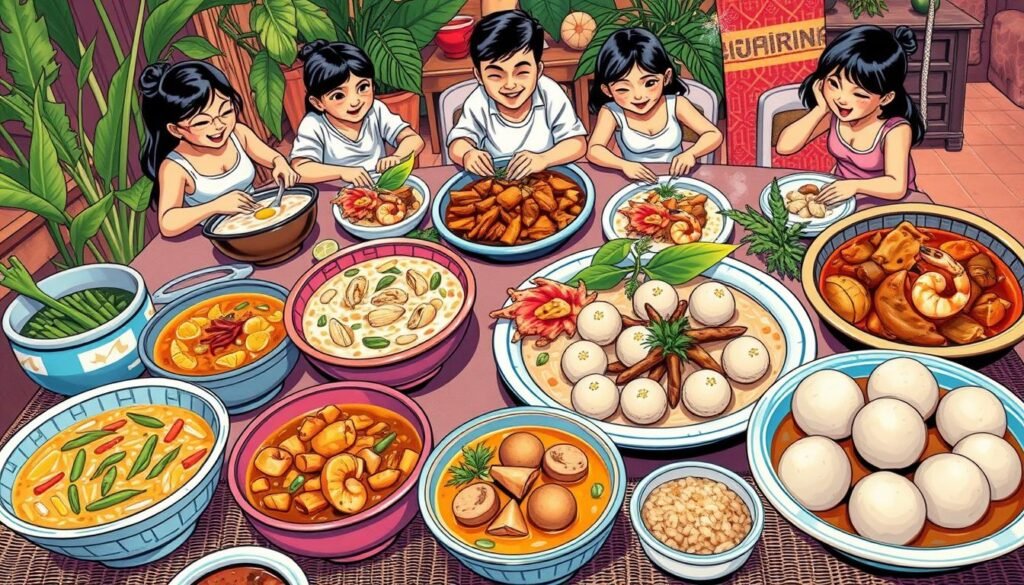
In Filipino cooking, coconut milk ties many dishes together, including savory Ginataan versions. It adds a creamy texture and unique flavor that goes well with many ingredients. Whether you want something light or rich, there’s a savory Ginataan dish for you.
| Dish | Ingredients | Cooking Time |
|---|---|---|
| Ginataang Sitaw and Malunggay | Coconut milk, sitaw, malunggay leaves, garlic, onion | 30-40 minutes |
| Ginataang Prawns | Coconut milk, prawns, tomatoes, lemongrass, chili peppers | 20-25 minutes |
Discovering savory Ginataan shows the depth and variety of Filipino cuisine. Coconut milk is key in making dishes that are both tasty and fulfilling.
Nutritional Aspects of Ginataan
Ginataan is a tasty Filipino dish with health benefits. Its main ingredient, coconut milk, is packed with nutrition. It has healthy fats and protein. The health benefits of coconut milk make it great for a balanced diet.
A serving of Ginataan has about 478.1 calories. It has 21.6g of fat, 71.6g of carbs, and 4.5g of protein. It’s also rich in vitamins A, C, calcium, and iron. To enjoy Ginataan’s sweet and savory flavors, knowing the health benefits of coconut milk and other ingredients is key.
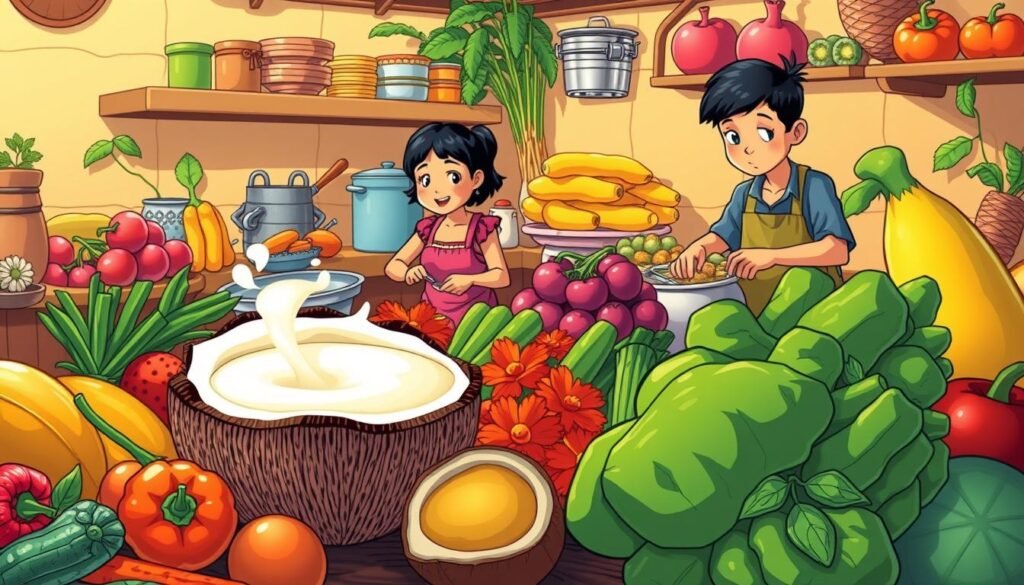
Nutritional Information
| Nutrient | Amount per serving | Daily Value |
|---|---|---|
| Total Calories | 478.1 | |
| Total Fat | 21.6g | 33% |
| Saturated Fat | 18.9g | 118% |
| Sodium | 62.2mg | 3% |
| Potassium | 610.4mg | 17% |
Knowing the nutritional aspects of Ginataan and the health benefits of coconut milk helps. It lets people enjoy this delicious Filipino dish while keeping a balanced lifestyle.
Ginataan as a Snack or Dessert
Ginataan is a beloved Filipino dish, enjoyed as a snack or dessert. It showcases the Philippines’ rich agricultural heritage. It’s a staple for agricultural workers needing energy before work.
Ingredients like plantains, jackfruit, and glutinous rice flour are key. About two cups of glutinous rice flour are used to make the rice balls. The recipe emphasizes using fresh ingredients, with frozen or canned options for when fresh ones are hard to find.
Ginataan pairs well with other Filipino dishes like lechon or adobo. Here are some tasty pairings:
- Lechon and ginataan: a classic combo for Filipino celebrations
- Adobo and ginataan: a mix of savory and sweet, perfect for any time
- Barbecue and ginataan: a sweet and smoky treat for outdoor events
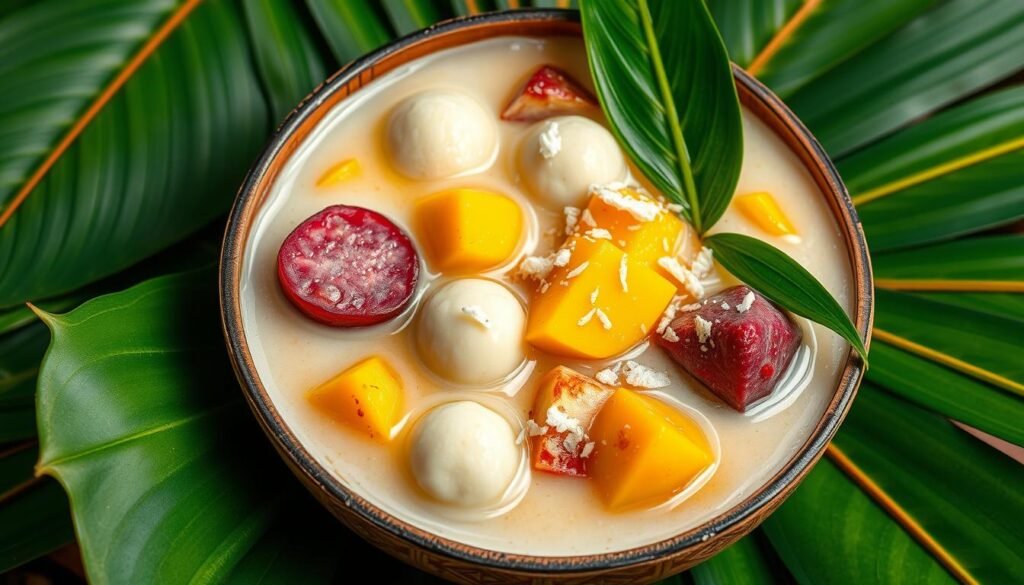
Ginataan is a versatile dish, loved as a snack or dessert. Its creamy texture and sweet flavors make it a favorite. It’s a great choice for a quick snack or a satisfying dessert.
| Ingredient | Quantity |
|---|---|
| Glutinous rice flour | 2 cups |
| Plantains | 6 |
| Jackfruit | 10 pieces |
Emotional and Cultural Significance
Ginataan holds a special place in the hearts of Filipinos. It symbolizes cultural significance and family traditions. It’s often served at special occasions like weddings and holidays. It’s a staple in Filipino culture.
Making Ginataan involves gathering ingredients and preparing coconut milk. It also requires hand-mixing, which is hard work.
The cultural significance of Ginataan is clear during Holy Week in the Philippines. It’s known as Binignit then. This dessert is made with saba bananas, gabi, kamote, jackfruit, tapioca pearl, landang glumps, coconut milk, and glutinous rice.
Making Filipino food, like Ginataan, is a way to preserve culture. It’s important for 2nd generation immigrants. It shows the value of family traditions in keeping cultural heritage alive.

In Filipino culture, Ginataan is more than a dessert. It’s a symbol of cultural significance and family traditions. It brings people together, creating a sense of community and belonging.
Exploring Ginataan’s emotional and cultural significance shows its importance. It plays a key role in preserving family traditions and cultural heritage.
Cooking Tips for Beginners
Starting with Filipino cooking can be tough, but it’s doable. To make a tasty Ginataan, focus on the coconut milk’s consistency. Adjust the water and cooking time to get it right.
It’s key to avoid common mistakes. Overcooking makes the dish thick and unappealing. Undercooking makes it runny and tasteless. Stick to a good recipe and watch the cooking time closely.
Here are some tips for beginners:
- Choose fresh, quality ingredients for the best taste and texture.
- Customize the spices and seasonings to your liking.
- Feel free to try new twists on the dish.

With these tips and practice, beginners can get good at making Filipino dishes like Ginataan. Patience and the right guidance will help you enjoy the rich flavors and traditions of Filipino cuisine.
| Cooking Time | Ingredient | Quantity |
|---|---|---|
| 10 minutes | Fish sauce | 2 tablespoons |
| 12 minutes | Coconut milk | 1 cup |
Popular Brands and Products
Cooking Filipino food, like Ginataan, is easier with popular brands and products. Knorr is a trusted name in the Philippines for over 50 years. They offer products that enhance Ginataan dishes’ flavor.
Knorr’s Ginataang Gulay Mix is a favorite among Filipino cooks. It has sustainable ingredients and no artificial colors or preservatives. This mix is great for dishes like Ginataang Gulay, Monggo, and Kalabasa. Prices range from ₱110.05 to ₱188.05, making them affordable.
Local Brands Offer Ginataan Ingredients
Other local brands also offer Ginataan ingredients and ready-to-cook options. Brands like Del Monte, Nestle, and Universal Robina are available. When choosing, look at ingredient quality, ease of preparation, and price.
Ready-to-Cook Ginataan Options
For convenience, there are ready-to-cook Ginataan products. You can find them in supermarkets and online. Knorr’s Ginataang Gulay Mix and Del Monte’s Ginataan Sauce are popular choices.
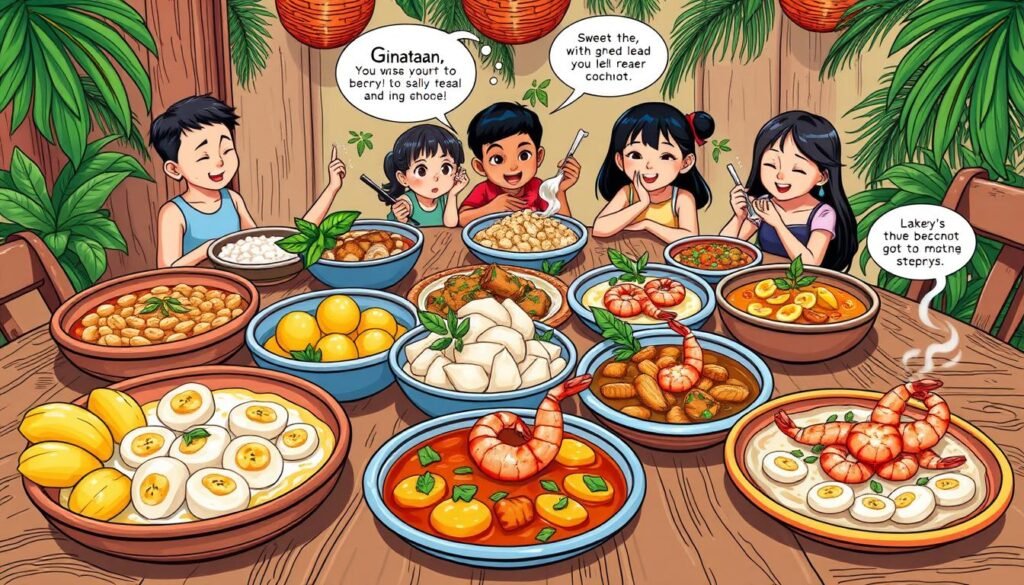
Many brands and products make cooking Ginataan easier and more fun. By picking the right ingredients and products, you can make delicious Ginataan dishes. These dishes are sure to impress.
Variations for Dietary Restrictions
Ginataan, a traditional Filipino dish, can be made for different diets. This includes vegan, vegetarian, and gluten-free options. It’s a great choice for those with special dietary needs.
When making Ginataan, it’s important to watch the ingredients. Coconut milk, a key ingredient, is naturally gluten-free. It works well in vegan and vegetarian dishes.
Vegan and Vegetarian Ginataan Recipes
Vegan and vegetarian Ginataan recipes use plant-based proteins. Here are some ideas:
- Tofu or tempeh for a protein-rich vegan version
- Vegetables like eggplant, okra, or bitter melon for a vegetarian version
- Mushrooms, such as shiitake or oyster mushrooms, for added flavor and texture
Gluten-Free Options
For gluten-free Ginataan, use gluten-free ingredients. Here are some tips:
- Use gluten-free soy sauce or tamari
- Avoid ingredients with gluten, like wheat or barley
- Prepare the dish in a dedicated gluten-free area

By making Ginataan for different diets, everyone can enjoy it. Whether you’re vegan, vegetarian, or gluten-free, there are many options to try.
| Dietary Restriction | Ginataan Adaptation |
|---|---|
| Vegan | Use plant-based protein sources, such as tofu or tempeh |
| Vegetarian | Use vegetables, such as eggplant or okra, as the main ingredient |
| Gluten-Free | Use gluten-free ingredients, such as gluten-free soy sauce, and avoid cross-contamination |
Serving Suggestions
Ginataan is a versatile dish perfect for any occasion. You can serve it with steamed rice or as a side to other Filipino dishes. To make it look great, try garnishing with toasted coconut flakes or fresh herbs.
Ginataan can be enjoyed warm or cold, depending on what you like. It’s perfect for parties or gatherings because it makes a lot. For more ideas, check out Kawaling Pinoy and explore Filipino cuisine.
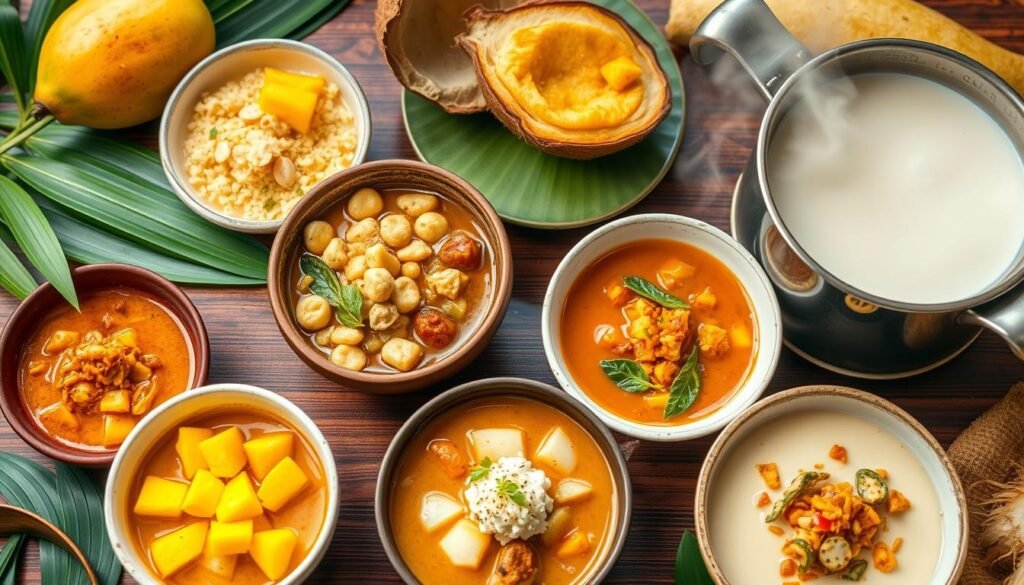
Popular pairings for Ginataan include grilled meats, seafood, or veggies. The creamy coconut milk sauce complements many flavors. It’s a crowd-pleaser at any event, and you can customize its presentation for any occasion.
Ginataan in Filipino Cuisine Context
Ginataan is a big deal in Filipino cuisine, loved at festivals and special times. It’s a favorite in many homes. People love it for its many uses and tastes.
In Filipino cooking, Ginataan is a snack or dessert. Its fame comes from coconut milk, used in many Filipino dishes. This milk adds richness to both savory and sweet foods.
When you compare Ginataan to other Filipino dishes, its taste stands out. It’s rich from coconut milk and sweet from fruits and root crops. It’s a hit at festivals and celebrations, enjoyed by everyone.
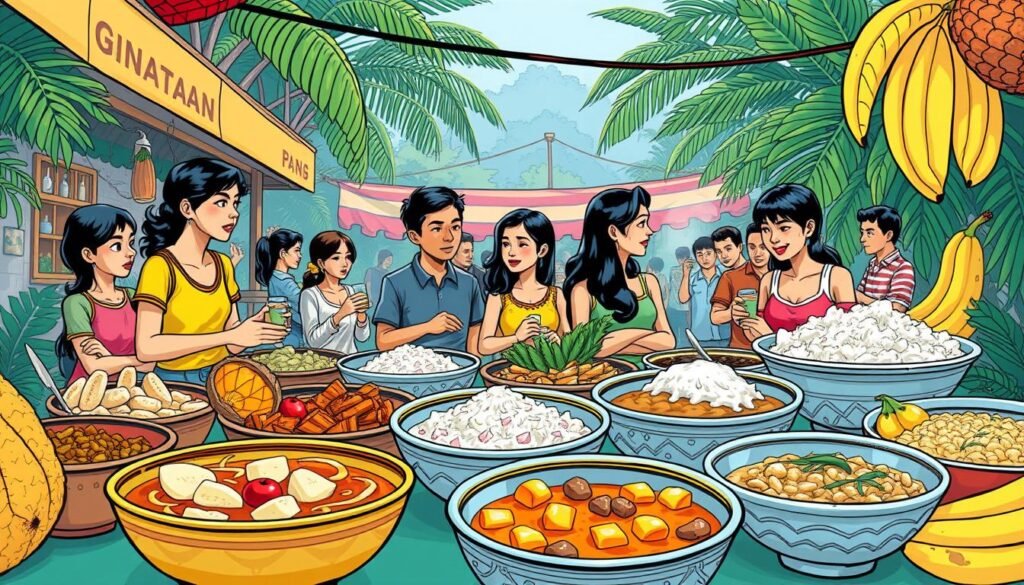
Ginataan is like other coconut dishes, but it’s special. Its taste and uses make it a key part of Filipino food. For more on Filipino festivals, check out this website.
Conclusion
As we wrap up our journey into the world of Ginataan, we invite you to start your own cooking journey. This Filipino favorite mixes sweet and savory tastes, making it perfect for any kitchen. You can stick to classic recipes or try new twists, and the joy of making Ginataan at home is unmatched.
Learning to make Ginataan lets you connect with Filipino culture and its varied flavors. With creamy coconut milk, colorful veggies, and proteins, every bite is a treat. As you explore Ginataan, you’ll learn to mix ingredients, get the right texture, and balance flavors.
So, start your cooking adventure today! Look for Ginataan recipes, try new ingredients, and enjoy making this Filipino dish in your kitchen. Share the joy of homemade Ginataan with your loved ones.
FAQ
What is Ginataan?
Ginataan is a dish from the Philippines that can be sweet or savory. It’s a favorite comfort food, enjoyed at special times. Coconut milk makes it creamy and rich.
What is the historical background of Ginataan?
Ginataan started before the Philippines was colonized. Coconut milk was key in Filipino cooking back then. Over time, it evolved with different cultures and traditions.
What are the common ingredients used in Ginataan?
Coconut milk is the main ingredient, making it creamy. It also includes veggies, fruits, and proteins.
How do you prepare basic Ginataan?
Making Ginataan is simple. You need just a few ingredients. This guide will help you pick the right ones and cook it perfectly.
What are the sweet variations of Ginataan?
Ginataan can be sweet, like Ginataang Bilo-Bilo and Ginataang Sago and Langka. These are loved desserts in the Philippines.
What are the savory variations of Ginataan?
Ginataan can also be savory, like Ginataang Sitaw and Malunggay. These are main dishes in the Philippines.
What are the health benefits of Ginataan?
Coconut milk, the main ingredient, is full of healthy fats and protein. Mixing sweet and savory flavors makes it both healthy and tasty.
How can Ginataan be served as a snack or dessert?
Ginataan is great as a snack or dessert. It’s often paired with other Filipino dishes. There are also modern ways to enjoy it.
What is the emotional and cultural significance of Ginataan?
Ginataan holds a special place in Filipino culture and emotions. It’s served at big events and is a key part of Filipino food. It brings up family traditions and memories.
What are some tips for beginners cooking Ginataan?
Cooking Ginataan takes practice, but with these tips, beginners can do it well. Learn how to get the right consistency and avoid mistakes.
What are some popular brands and products for Ginataan?
Many brands offer Ginataan ingredients and ready-to-cook options. It’s important to choose the right one for your needs.
Are there variations of Ginataan for dietary restrictions?
Yes, there are vegan and vegetarian Ginataan options for those with dietary restrictions.
How can Ginataan be served with other dishes?
Ginataan goes well with rice and side dishes. There are also creative ways to present it.
How does Ginataan fit into the context of Filipino cuisine?
Ginataan is a big part of Filipino cuisine and festivals. It’s compared to other dishes and its role in food culture.
Source Links
- All about Ginataan. Types of Ginataan, Ginataan recipes and the origin of Ginataan. The World Food Wiki. – https://www.worldfoodwiki.com/ginataan
- Young Jackfruit in Coconut Milk, Ginataang Langka – ASTIG Vegan – https://www.astigvegan.com/young-jackfruit-in-coconut-milk-ginataang-langka/
- Ginataang Hipon Sitaw at Kalabasa – https://panlasangpinoy.com/ginataang-hipon-sitaw-at-kalabasa/
- Ginataan – https://en.wikipedia.org/wiki/Ginataan
- Ginataan Bilo Bilo Recipe (Rice Balls, Sweet Potato & Coconut Dessert) – https://www.hungryhuy.com/ginataan-bilo-bilo/
- Knowing Filipino Food: Ginataan – https://theadobros.substack.com/p/knowing-filipino-food-ginataan
- Ginataang Bilo Bilo – https://www.kawalingpinoy.com/ginataang-bilo-bilo/
- Ginataang Bilo bilo with Langka Recipe – https://panlasangpinoy.com/ginataang-bilo-bilo-langka-recipe/
- Ginataang Gulay – https://www.kawalingpinoy.com/ginataang-gulay/
- Ginataang Bilo bilo (sticky rice balls in coco milk) – Foxy Folksy – https://www.foxyfolksy.com/ginataang-bilo-bilo-sticky-rice-balls-in-coco-milk/
- Classic Ginataan Bilo-Bilo (Filipino Sticky Rice Balls in Coconut Milk) | Fork & Spoon – https://itsforkandspoon.com/classic-ginataan-bilo-bilo-filipino-sticky-rice-balls-in-coconut-milk/
- Ginataan (Mixed fruits in Sweet Coconut Milk) – https://bambinocooks.wordpress.com/2009/11/16/ginataan-mixed-fruits-in-sweet-coconut-milk/
- Ginataan – https://www.latestrecipes.net/2010/07/20/kulinarya-cooking-club-ginataan/
- The Spicy, Savory Prawns Recipe That Connects Me to My Roots – https://www.thekitchn.com/ginataan-na-sugpo-recipe-23228274
- Ginataan – AMCARMEN’S KITCHEN – https://amcarmenskitchen.com/tag/ginataan/
- How to Cook Ginataan Bilo-bilo, a Filipino sweet soup snack – https://sarahlynnpablo.blog/2012/12/03/how-to-cook-ginataan-bilo-bilo-a-filipino-sweet-soup-snack/
- Ginataang Mais Recipe – https://theunlikelybaker.com/ginataang-mais-recipe/
- Binignit: A fusion of history, tradition, and sacrifice in every bowl – https://www.rappler.com/philippines/mindanao/binignit-fusion-history-tradition-sacrifice/
- Celebrating My Heritage – https://globalmindscollective.com/blogs/news/celebrating-my-heritage
- Female Friendship in Mia Manansala’s "Guilt and Ginataan" – Chicago Review of Books – https://chireviewofbooks.com/2024/11/12/female-friendship-in-mia-manansalas-guilt-and-ginataan/
- Ginataang Tilapia Recipe – https://panlasangpinoy.com/ginataang-tilapia/
- Ginataang Manok – https://www.kawalingpinoy.com/ginataang-manok/
- Knorr Ginataang Gulay Recipe Mix – https://www.knorr.com/ph/p/ginataang-gulay-recipe-mix.html/04800888603364
- 5 Ginataang Gulay Recipes Below ₱200 – https://www.knorr.com/ph/recipes/recipe-tips/affordable-ginataang-gulay-recipes.html
- How Does the Ginataan (Cooked in Coconut Milk) Technique Influence the Taste of Seafood Dishes in the Philippines? – pinascuisine.com – https://pinascuisine.com/ginataan/
- Filipino Food and Supplements: A Winning Combination for Wellness – https://richestph.com/filipino-food-and-supplements-a-winning-combination-for-wellness/
- Date: March 3, 2015 – https://fnri.dost.gov.ph/images/sources/media/2017/Jan-Mar-2017.pdf
- Ginataang Munggo – https://www.kawalingpinoy.com/ginataang-munggo/
- Ginataang Gulay ( Vegetables in Coconut Milk ) – http://homemadediyluxes.blogspot.com/2013/06/ginataang-gulay-vegetables-in-coconut.html
- The Happy Home Cook: Ginataang Langka (Young Jackfruit in Coconut Milk) — Positively Filipino | Online Magazine for Filipinos in the Diaspora – https://www.positivelyfilipino.com/magazine/the-happy-home-cook-ginataang-langka-young-jackfruit-in-coconut-milk
- Farm to Table: Filipino Ginataan using Summer Squash — NOURISHED by Asha – https://nourishedbyasha.com/blog/rkspoonnknife.com/2010/07/farm-to-table-filipino-ginataan-using.html
- Ginataang Bilo Bilo Recipe – https://hicaps.com.ph/ginataang-bilo-bilo-recipe/?srsltid=AfmBOoqE88MxY2iqDQjO-1aBbUhKBONyRK94mHLvd2UzVyXIRFftCZeq
- Ginataang Bilo Bilo Recipe – https://www.pinterest.com/ideas/ginataang-bilo-bilo-recipe/909461076554/

